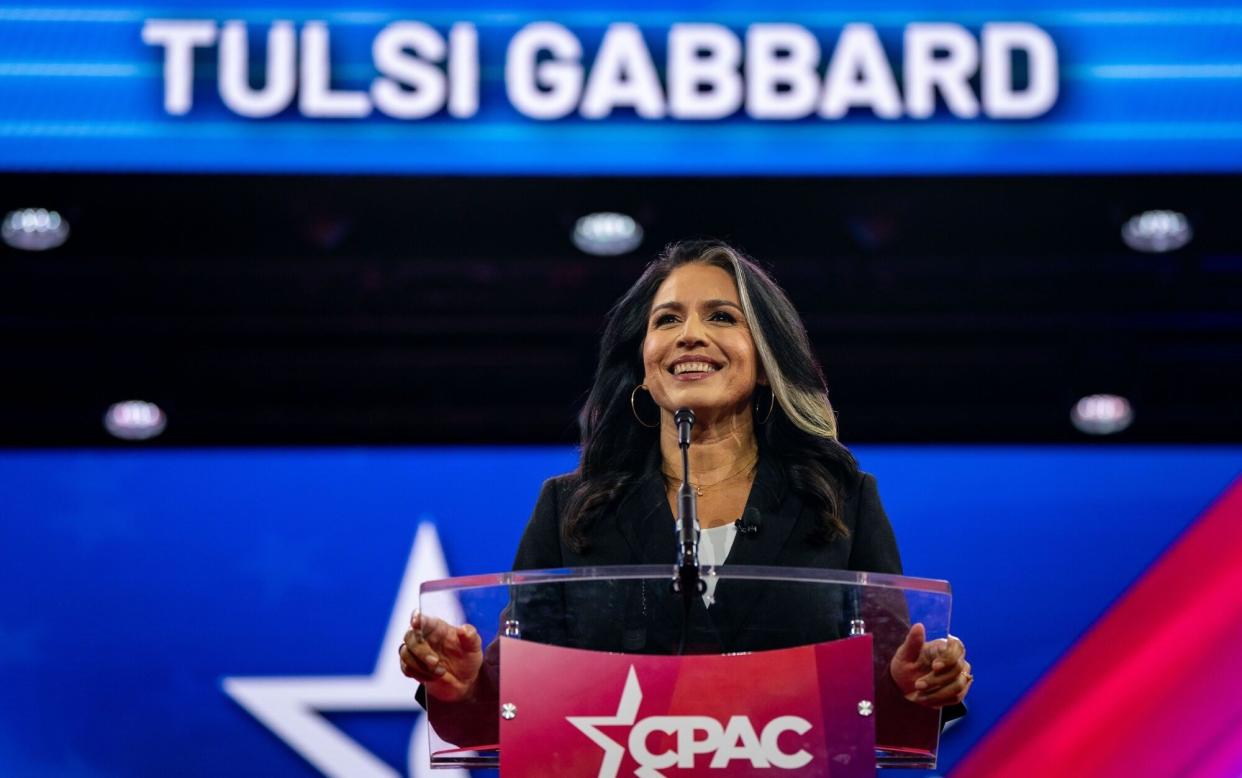Tulsi Gabbard is running for Opportunist-in-Chief

- Oops!Something went wrong.Please try again later.
- Oops!Something went wrong.Please try again later.
Now that True Detective has been officially renewed for a fifth season, here’s an enduring mystery that the next set of TV gumshoes could tackle: Tulsi Gabbard.
The enigmatic Hawaiian-born politician-turned-pundit is front page news again after Donald Trump let slip that she’s on his vice presidential shortlist. This week, she sang the praises of the former president from the podium at CPAC as “a fighter, his strength, and resilience can only come from... a sincere love and concern for the future of our country and his care for the American people,” and is slated to be the keynote speaker at a Trump fundraiser in Mar-a-Lago on March 7.
None of this is particularly shocking considering her recent career arc as a Fox News contributor and rising star of the Tucker-verse, as in Tucker Carlson’s brand of Maga-friendly right-wing populist media. Still, for those who’ve followed her political career closely before she loudly divorced the Democratic Party in 2022, it’s quite discombobulating. Gabbard served as the Vice Chair of the DNC as recently as 2016 and endorsed “her old friend” Biden in 2020.
What’s changed for Gabbard so dramatically since then?
I remember the first time and only time I met Tulsi – under the blazing sun of the Iowa State Fair in the summer of 2019. Then, she was a relatively obscure Democratic congresswoman trying to rouse some votes from potential Iowa caucusers at the fair’s political soapbox. She’d just played some carnival games with fairgoers, and we chatted briefly before she took to the stage at the fair’s political soapbox.
I sensed that she was a rising star, a charismatic insider who spoke like a populist, an anti-establishment outsider. Indeed, her stump speech often sounded like the same one delivered by Bernie Sanders the next day, albeit with way less hoarse yelling. She called for Medicare for All, criminal justice reform, legal weed, and a policy move away from fossil fuels to address climate change.
Yet, even then, her oratory was of a different tenor than most of the other progressives at the fair. Like Sanders, she was openly critical of the Democratic Party and the bipartisan war machine. But unlike, say, Elizabeth Warren, who kept awkwardly invoking identity groups like “Latinx” every few minutes as a kind of sacrament, Gabbard didn’t emphasise issues of identity.
She didn’t mention that she was the first Hindu member of Congress and the first Samoan-American voting member; instead, she admirably focused on her identity as a combat veteran and the universalism of being an American.
She was never a perfect fit for the path the Democrats were going, and indeed, the party establishment and the media initially ignored her candidacy. But the long knives came out once she excoriated Kamala Harris during a TV debate in 2019.

Harris accused her campaign of being part of a nebulously defined Russian conspiracy, and Hillary Clinton claimed that Putin was “grooming” her to be a pro-Russia third-party candidate. Gabbard responded by calling Hillary “the queen of warmongers” and sued her for $50 million, but the DNC-friendly corporate media almost universally took Clinton’s side.
Gabbard eventually dropped out of the 2020 race and backed Biden, but the rift between her and the Democratic party seemed irreconcilable. So, perhaps we should have seen her 2022 defection to the GOP coming, especially to the Trump wing of the intra-party civil war. As the logic goes, the enemy of my enemy is my friend.
But what’s disappointing about her recent Maga makeover is that she’s abandoned a lot of the positive portions of the Sanders agenda she once espoused, policies designed to help working people: higher wages, better health care, and stronger unions (she got a 100 per cent voting score as a congressperson from the AFL-CIO). Instead, she now dismisses all aspects of Bidenomics as “fascism” and plays up the culture wars.
Perhaps that’s just shrewdness. But I’m far from the only observer to wonder: Is her blue-to-red reversal a reflection of being a principled actor who shifted alliances during the Trump-driven political realignment of the two major parties since 2016? Or is she an idiosyncratic chameleon who only said “Aloha!” to the GOP after her presidential bid wiped out hard with the blue-shaded electorate?
The answer, as unsatisfying as it is to say, might be a little of both.

